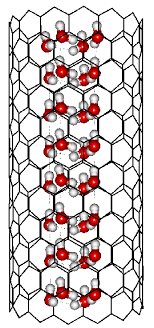Raman Resonance Spectroscopy (RAMAN) for SWCNTs Frequency Sensing (Based on Nano-Microelectronics PhD)
Researcher and author: PhD student : Afshin Rashid)

Note: This method is very common to measure the frequency of nanotubes in a sample. In this technique, when the laser energy is equal to or near the permitted electron transfer energy of the sample, we will increase the intensity, which is highly dependent on the sample's nanoelectric structure.
In the RRS, even carbon nanotubes can be found in a single nanotube Raman. The Raman spectrum of a single nanotube enables the electron structure and phonon structure of SWCNTs to be more accurately estimated. Each carbon nanotube (m, n,) has a special electron structure and therefore has its own specific density . Therefore RRS is excellent for determining their structure . Nanotubes having diameters of 0/75 nm <dt <2 / 4nm SWNTs (SWCNTs) , RBM Raman spectra between them which appear to be (100cm-1 <WRBM <300cm) equivalent to the symmetric transitions within the atoms SWCNT carbon is in radial direction. band G related to the motion of neighboring atoms in The opposite direction is along the pipe surface in two-dimensional graphite characterized by a multi- branch peak around (1-1600cm-1500). The RBM peak and the multi band G peak are not seen in SP2. Usually no carbon compound SP2 is a peak of compounds containing single carbon (band G) Lorentzian in the range of (1-1582cm) their Raman spectrum. D band in Raman spectra for atoms SP2 in the presence of (hetero) atoms, the atmosphere of carbon empty or any network failures occur.

All of these peaks in the Raman spectrum are sensitive to the SWCNT structure (indices m, n). Of course, RBM is more sensitive and is therefore used for initial identification (m, n). ( band G) is also sensitive to the electron structure. Band G and RBM are widely used to arrange nanotubes . By Raman spectroscopy using a large number of laser lines, the exact diameter distribution can be obtained and finally more precisely the SWCNT metal and semiconductor type are determined. Band G has been shown to be different from metallic and semiconductor nanotubes . In graphite, band G is a unique peak because the tangential vibrations on the plate are of the degenerate planar hexagonal structure while in the nanotubes, this peak is It breaks down to six peaks due to graphene plate curvature and quantum confinement along the tube. Considering only two of the extreme peak failures and their analysis, which is basically the symmetry of the tangential vibration when the graphene plate is bent to form the tubular cylinders , it is possible to obtain good information . Two of the strongest G peaks with G + are named for -G shifts . -G are defined with less atomic frequency along the tube axis and to rotate atomically in the direction of the circles . The difference between G-metal (SWCNTs band-G) and semiconductors is evidence of this. Peak metal nanotubes are wider than semiconductors It is more asymmetric and shifts to lower frequencies .

Conclusion :
Semiconductor nanotubes can be switched on / off in coordination with the voltage regulator. To distinguish metallic and semiconductor SWCNTs using VI diagrams are presented. The researchers hypothesized that semiconductor SWCNTs have an on / off ratio of 10 or higher and have an off-current ratio of (9A-10) or less, which is contrary to the properties of metallic SWCNTs. In addition, for enriched samples, four-point measurements are made on paper bucky films to quantify the frequency of metallic and semiconductor types in the sample. However, many other factors such as sample purity and uniformity of the layer thickness can be layer resistance. Affect the thin. These factors must be considered before concluding.

